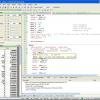 The DIGITAL WORKERS (MR.KNOW) offers application development without programming. The developments can be shared with others.
The DIGITAL WORKERS (MR.KNOW) offers application development without programming. The developments can be shared with others. ADbasic is a complete development environment for programming fast control and measurement sequences - based on our worldwide known and thousandfold proven ADwin systems. With ADbasic, problems can be solved easily, with high precision and with exactly predictable timing: Fast digital control, measurement, Maintain hard real-time under Windows, Linux, Mac - with microsecond accuracy, Easy implementation, Stay flexible in the choice of hardware and software interfaces, Scalable and downward compatible, Interfaces for standard software ...
ADbasic is a complete development environment for programming fast control and measurement sequences - based on our worldwide known and thousandfold proven ADwin systems. With ADbasic, problems can be solved easily, with high precision and with exactly predictable timing: Fast digital control, measurement, Maintain hard real-time under Windows, Linux, Mac - with microsecond accuracy, Easy implementation, Stay flexible in the choice of hardware and software interfaces, Scalable and downward compatible, Interfaces for standard software ... ADlog reliably executes measurement tasks with an exactly predictable time reponse, the channels are acquired synchronously. Depending on your tasks intelligent, online adaptable pre-processing will be possible, e.g. filtering or transient functions. ADlog automatically and continuously measures sample rates of up to 4.8 MHz (e.g. 32 analog channels with 16 bit and 150 kHz each). ADlog displays the data in up to 8 diagram windows, which can be adjusted with zoom and monitoring of individual channels ...
ADlog reliably executes measurement tasks with an exactly predictable time reponse, the channels are acquired synchronously. Depending on your tasks intelligent, online adaptable pre-processing will be possible, e.g. filtering or transient functions. ADlog automatically and continuously measures sample rates of up to 4.8 MHz (e.g. 32 analog channels with 16 bit and 150 kHz each). ADlog displays the data in up to 8 diagram windows, which can be adjusted with zoom and monitoring of individual channels ... A digital company's daily routine is very dependent on good and trouble-free software. Randomness has no place in achieving the business goals and generating success. With the SPiCE-Lite Assessment Tool, however, it is easy to quickly recognise and evaluate all important information and, if necessary, take countermeasures in case of problems. This tool enables you to fully analyse and assess all software development processes or even your internal IT service management. . The SPiCE-Lite Assessment software tool comes into play exactly where time and other resources are often lacking in everyday life ...
A digital company's daily routine is very dependent on good and trouble-free software. Randomness has no place in achieving the business goals and generating success. With the SPiCE-Lite Assessment Tool, however, it is easy to quickly recognise and evaluate all important information and, if necessary, take countermeasures in case of problems. This tool enables you to fully analyse and assess all software development processes or even your internal IT service management. . The SPiCE-Lite Assessment software tool comes into play exactly where time and other resources are often lacking in everyday life ... The ContinoProva testing tool is a tool that integrates hardware and software tools for automated testing. Do you already have test and development tools in use? No problem, they can be linked to the solution. The definition of test specifications is simple and possible without the use of scripting languages. You can set breakpoints and run tests up to the breakpoint so that you can display the current values of signals and variables.
The ContinoProva testing tool is a tool that integrates hardware and software tools for automated testing. Do you already have test and development tools in use? No problem, they can be linked to the solution. The definition of test specifications is simple and possible without the use of scripting languages. You can set breakpoints and run tests up to the breakpoint so that you can display the current values of signals and variables. Accelerate your digitization with the X4 BPM Suite. The central platform for all digitization tasks stands for low code – modeling instead of programming. With the X4 Designer, you solve your tasks graphically. You can integrate users into processes using target group-oriented interfaces and input masks. And more than 200 standardized adapters are available to connect your IT systems. In addition, a simple controlling system ensures that you always have an overview of systems, processes and data.
Accelerate your digitization with the X4 BPM Suite. The central platform for all digitization tasks stands for low code – modeling instead of programming. With the X4 Designer, you solve your tasks graphically. You can integrate users into processes using target group-oriented interfaces and input masks. And more than 200 standardized adapters are available to connect your IT systems. In addition, a simple controlling system ensures that you always have an overview of systems, processes and data. Magic xpi - Integration Platform relies on user-friendly, code-free tools with a graphical user interface and wizards equipped with drag and drop functionality. IT professionals and business analysts can easily create integration workflows without the need for programming skills. Of course, your IT experts can add their own code at any time if required.
Magic xpi - Integration Platform relies on user-friendly, code-free tools with a graphical user interface and wizards equipped with drag and drop functionality. IT professionals and business analysts can easily create integration workflows without the need for programming skills. Of course, your IT experts can add their own code at any time if required. ENERGY PROCESSES offers all the essential features for mapping all processes in your energy supply company. Processes can be executed without programming.
ENERGY PROCESSES offers all the essential features for mapping all processes in your energy supply company. Processes can be executed without programming. MR.KNOW provides with LOW-CODE & NO-CODE-BPM as well as the MR.KNOW - PLATFORM and the digital wizards extensive possibilities for project leaders and project managers for the implementation of your projects. Model and automate your processes with one of the most powerful BPM software on the market. MR.KNOW - BPM supports as a holistic Business Process Management Suite (BPMS) with the modules Processboard, Modeling, Automation, Low Coding, User Interfaces, Process Portal as well as Monitoring in the creation of business processes and enables a fast implementation of enterprise-wide solutions.
MR.KNOW provides with LOW-CODE & NO-CODE-BPM as well as the MR.KNOW - PLATFORM and the digital wizards extensive possibilities for project leaders and project managers for the implementation of your projects. Model and automate your processes with one of the most powerful BPM software on the market. MR.KNOW - BPM supports as a holistic Business Process Management Suite (BPMS) with the modules Processboard, Modeling, Automation, Low Coding, User Interfaces, Process Portal as well as Monitoring in the creation of business processes and enables a fast implementation of enterprise-wide solutions.